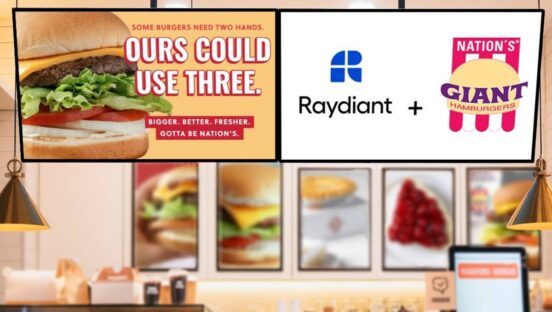





Quick-service restaurants outperformed the fiercely competitive broader market in 2018 despite static sales within the industry and major shifts in customer demands. As 2019 revs up, restaurant chains will be faced with elevated customer expectations and new opportunities to drive growth through differentiated digital experiences.
To bolster their position as industry innovators, expect quick-serves to add additional engagement mechanisms for customers—both inside and outside their four walls. The following are the top five technology trends we can expect to create the greatest opportunities for the industry this year.
Anytime, anywhere ordering
Mobile is not the future. It is the now, as more consumers are picking up their smartphones when the hunger pangs strike. In a recent survey by Market Force Information, nearly 40 percent of consumers said they had placed a food order using their smartphone within the past 90 days—a marked increase from 2015, when only 11 percent reported using mobile order-ahead offerings.
This year, expect chain restaurants to serve up even greater convenience for customers with their mobile and remote ordering capabilities. In-store options will also expand, including digital kiosks, tabletop devices and iPad ordering, and as Alexa and other voice-activated AI technologies join more households and work places, factoring these devices into the mix will become necessary as well.
Not only do digital ordering capabilities enhance the customer experience by making it easier to customize items, cut down on time in store, bypass long lines and eliminate the hassle of paying in person, but these platforms create efficiencies for the business as well—reducing employee labor and increasing sales volumes.
Meanwhile, as mobile and remote ordering drives more people in-store for rapid pick-up, expect to see more restaurants redesigning their store space and designating areas for customers to pick up their orders. Stores will increasingly feature digital displays to let customers know their order’s status in the queue, further optimizing the ordering experience.
Signage goes digital
Speaking of digital displays, quick-serves will continue to adopt digital signage and other in-store screens that display restaurant menus or other content, such as news, weather, sports, branded social media dashboards or live promotions. These dynamic displays can also switch between multiple content sources and boost customers’ dining experience by engaging them and reducing perceived wait time by up to 35 percent, according to a Lavi Industries study.
Digital signage can also expand customers’ baskets—for example, by highlighting various menu items during breakfast, lunch or dinner, or showcasing special offerings throughout the week.
Digital signage also provides much greater brand/price control at the corporate level for quick-service brands that have struggled in a franchise model that favors localized autonomy.
More rewarding rewards
Rewards, rewards, rewards! Engaging with customers has never been as possible—and paramount—for quick-serves as it is today. Now, they can communicate with their customers through multiple channels—in their inbox, via mobile apps and notifications on their phones, through in-store digital signage and beyond. However, consistent and personalized messaging is key to driving engagement, loyalty and purchases.
Increasingly, restaurants must integrate loyalty programs across mobile, web, digital signage, social media, email and other platforms in order to harness the power of data and reach consumers most effectively. This integration helps ensure consistency and enables quick-serves to hone in on customer preferences, market more effectively to individuals and ultimately offer a frictionless loyalty-program experience with targeted, personalized rewards.
Customer predictability
As quick-serves continue to adopt new digital platforms for customers to use and build mobile applications with growing offerings and digital engagement, suddenly, they are awash in data. How quick-service restaurants harness data from digital channels and point-of-sale systems to leverage the information and improve customer experience and business operations is critical.
2019 will be the year quick-serves start using data for both personalized customer engagement as well their own operational efficiencies. By understanding day-to-day (and minute-to-minute) customer behavior (e.g., clickstream journey, visit frequency, purchase history, etc.)—in correlation with real-time sources such as weather, local sporting events and traffic—quick-serves will be able to dynamically staff their stores and control inventory much more efficiently and effectively.
Doing so will allow quick-service restaurants to make better, real-time decisions and ultimately improve their operating models.
Modernizing the framework
Technology is only as strong as the framework it’s built on. For example, a quick-service restaurant may have an outstanding app, but research shows that 67 percent of retail mobile users will delete an app after a single poor experience. To retain app users, it will be essential to adopt the right infrastructure and architectures to capture and analyze consumer behavior, and share data across franchises and corporate offices for better data-driven decision making.
This year, restaurant chains will continue to modernize their framework by integrating cloud, analytics, web and mobile; bridging gaps within CRM, call center and e-commerce applications; and adopting agile processes that can keep up with rapid software and hardware updates. By doing so, technology no longer becomes a disruption, but rather an opportunity to realize business outcomes.
Quick-serves are already headed into a strong 2019, even in the face of ever-shifting customer demands and pressures to maximize margins and efficiencies, and stand out within the industry. Those that continue to embrace these trends and put new digital and in-store technologies on the menu will ultimately win by keeping customers coming back for more. Quick-service restaurants seeking a technology partner to assist in these areas should look for one with deep knowledge of the latest retail products and services, experience working with multiple leading quick-serves, and one that can provide valuable insights on how various solutions will integrate into an existing infrastructure.
Matt Sebek is the Vice President of Digital at World Wide Technology. Matt helps major brands dream and develop delightful consumer and workforce experiences through human-centered design, insight-driven objectivity and the unique ability to understand and eliminate the challenges that exist between the business and IT. He has been instrumental in creating some of the most used and highest rated quick-serve, B2C and fast casual restaurant digital experiences over the past ten years.









